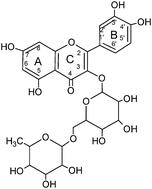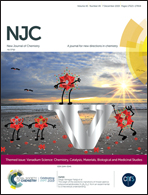Interactions of rutin with the oxidovanadium(iv) cation. Anticancer improvement effects of glycosylated flavonoids†
Abstract
This work reports the biological evaluation of the new complex Na2[VO(rut)(OH)2]·5H2O (rut = rutin, a glycosylated flavonoid). The complex was different in its coordination mode (catechol-like) from those previously reported, [VO(rutin)(H2O)2]2(SO4)·4H2O and [VO(rut)2]·4H2O (acetylacetonate-like coordination). Due to the coordination mode, the complex only improved the antioxidant activity of the ligand against superoxide and hydroxyl radicals. The results show that while both 100 µM rutin and V(IV)O did not exhibit cytotoxic activity on A549 cells, the complex selectively improved the anticancer effect (IC50 = 95 µM), cellular reactive oxygen species (ROS) generation and depletion of the non-enzymatic antioxidant glutathione (GSH), producing oxidized glutathione (GSSG), and it did not affect the viability of the normal embryonic lung cell line (MRC-5) (up to 100 µM). All these data, and given the reversion of the cell killing effect of the complex upon treatment with the antioxidant agent N-acetyl-L-cysteine (NAC), suggested an oxidative stress mechanism. Rutin and VOrut can spontaneously bind bovine serum albumin (BSA) and they can be stored and transported by the protein.

- This article is part of the themed collection: Vanadium Science: Chemistry, Catalysis, Materials, Biological and Medicinal Studies


 Please wait while we load your content...
Please wait while we load your content...